Linux shell command make & Makefile All In One
Linux shell command make & Makefile All In One
脚本
自动化构建工具
make & makefile
https://linux.xgqfrms.xyz/linux_basic/1010index.htm
make 第二十二章、1.3
https://linux.xgqfrms.xyz/linux_basic/0520source_code_and_tarball.htm#intro_make
makefile 第二十二章、3.2
https://linux.xgqfrms.xyz/linux_basic/0520source_code_and_tarball.htm#make_makefile
Makefile 是在 Linux 编程环境下 C/C++ 程序开发必须要掌握的一个工程管理文件;
当使用 make 命令去编译一个工程项目时,如果没有指定自定义的 Makefile 文件,make 才会首先到项目的根目录下去寻找默认文件名为 Makefile 的文件,然后再根据这个 Makefile 文件去执行编译程序;
C 程序的
编译连接过程

GNU make
macOS
$ man make
# 使用 vscode fix 输出 man doc 乱码问题 ✅
$ man make > man-make.md
$ man make
# 使用 vscode fix 输出 man doc 乱码问题 ✅
$ man make > man-make.md
MAKE(1) LOCAL USER COMMANDS MAKE(1)
NAME
make - GNU make utility to maintain groups of programs
SYNOPSIS
make [ -f makefile ] [ options ] ... [ targets ] ...
WARNING
This man page is an extract of the documentation of GNU make. It is
updated only occasionally, because the GNU project does not use nroff.
For complete, current documentation, refer to the Info file make.info
which is made from the Texinfo source file make.texi.
DESCRIPTION
The purpose of the make utility is to determine automatically which
pieces of a large program need to be recompiled, and issue the commands
to recompile them. The manual describes the GNU implementation of
make, which was written by Richard Stallman and Roland McGrath, and is
currently maintained by Paul Smith. Our examples show C programs,
since they are most common, but you can use make with any programming
language whose compiler can be run with a shell command. In fact, make
is not limited to programs. You can use it to describe any task where
some files must be updated automatically from others whenever the
others change.
To prepare to use make, you must write a file called the makefile that
describes the relationships among files in your program, and the states
the commands for updating each file. In a program, typically the
executable file is updated from object files, which are in turn made by
compiling source files.
Once a suitable makefile exists, each time you change some source
files, this simple shell command:
make
suffices to perform all necessary recompilations. The make program
uses the makefile data base and the last-modification times of the
files to decide which of the files need to be updated. For each of
those files, it issues the commands recorded in the data base.
make executes commands in the makefile to update one or more target
names, where name is typically a program. If no -f option is present,
make will look for the makefiles GNUmakefile, makefile, and Makefile,
in that order.
Normally you should call your makefile either makefile or Makefile.
(We recommend Makefile because it appears prominently near the
beginning of a directory listing, right near other important files such
as README.) The first name checked, GNUmakefile, is not recommended for
most makefiles. You should use this name if you have a makefile that
is specific to GNU make, and will not be understood by other versions
of make. If makefile is `-', the standard input is read.
make updates a target if it depends on prerequisite files that have
been modified since the target was last modified, or if the target does
not exist.
OPTIONS
-b, -m
These options are ignored for compatibility with other versions of
make.
-B, --always-make
Unconditionally make all targets.
-C dir, --directory=dir
Change to directory dir before reading the makefiles or doing
anything else. If multiple -C options are specified, each is
interpreted relative to the previous one: -C / -C etc is
equivalent to -C /etc. This is typically used with recursive
invocations of make.
-d Print debugging information in addition to normal processing. The
debugging information says which files are being considered for
remaking, which file-times are being compared and with what
results, which files actually need to be remade, which implicit
rules are considered and which are applied---everything
interesting about how make decides what to do.
--debug[=FLAGS]
Print debugging information in addition to normal processing. If
the FLAGS are omitted, then the behavior is the same as if -d was
specified. FLAGS may be a for all debugging output (same as using
-d), b for basic debugging, v for more verbose basic debugging, i
for showing implicit rules, j for details on invocation of
commands, and m for debugging while remaking makefiles.
-e, --environment-overrides
Give variables taken from the environment precedence over
variables from makefiles.
+-f file, --file=file, --makefile=FILE
Use file as a makefile.
-i, --ignore-errors
Ignore all errors in commands executed to remake files.
-I dir, --include-dir=dir
Specifies a directory dir to search for included makefiles. If
several -I options are used to specify several directories, the
directories are searched in the order specified. Unlike the
arguments to other flags of make, directories given with -I flags
may come directly after the flag: -Idir is allowed, as well as -I
dir. This syntax is allowed for compatibility with the C
preprocessor's -I flag.
-j [jobs], --jobs[=jobs]
Specifies the number of jobs (commands) to run simultaneously. If
there is more than one -j option, the last one is effective. If
the -j option is given without an argument, make will not limit
the number of jobs that can run simultaneously.
-k, --keep-going
Continue as much as possible after an error. While the target
that failed, and those that depend on it, cannot be remade, the
other dependencies of these targets can be processed all the same.
-l [load], --load-average[=load]
Specifies that no new jobs (commands) should be started if there
are others jobs running and the load average is at least load (a
floating-point number). With no argument, removes a previous load
limit.
-L, --check-symlink-times
Use the latest mtime between symlinks and target.
-n, --just-print, --dry-run, --recon
Print the commands that would be executed, but do not execute
them.
-o file, --old-file=file, --assume-old=file
Do not remake the file file even if it is older than its
dependencies, and do not remake anything on account of changes in
file. Essentially the file is treated as very old and its rules
are ignored.
-p, --print-data-base
Print the data base (rules and variable values) that results from
reading the makefiles; then execute as usual or as otherwise
specified. This also prints the version information given by the
-v switch (see below). To print the data base without trying to
remake any files, use make -p -f/dev/null.
-q, --question
``Question mode''. Do not run any commands, or print anything;
just return an exit status that is zero if the specified targets
are already up to date, nonzero otherwise.
-r, --no-builtin-rules
Eliminate use of the built-in implicit rules. Also clear out the
default list of suffixes for suffix rules.
-R, --no-builtin-variables
Don't define any built-in variables.
-s, --silent, --quiet
Silent operation; do not print the commands as they are executed.
-S, --no-keep-going, --stop
Cancel the effect of the -k option. This is never necessary
except in a recursive make where -k might be inherited from the
top-level make via MAKEFLAGS or if you set -k in MAKEFLAGS in your
environment.
-t, --touch
Touch files (mark them up to date without really changing them)
instead of running their commands. This is used to pretend that
the commands were done, in order to fool future invocations of
make.
-v, --version
Print the version of the make program plus a copyright, a list of
authors and a notice that there is no warranty.
-w, --print-directory
Print a message containing the working directory before and after
other processing. This may be useful for tracking down errors
from complicated nests of recursive make commands.
--no-print-directory
Turn off -w, even if it was turned on implicitly.
-W file, --what-if=file, --new-file=file, --assume-new=file
Pretend that the target file has just been modified. When used
with the -n flag, this shows you what would happen if you were to
modify that file. Without -n, it is almost the same as running a
touch command on the given file before running make, except that
the modification time is changed only in the imagination of make.
--warn-undefined-variables
Warn when an undefined variable is referenced.
EXIT STATUS
GNU make exits with a status of zero if all makefiles were successfully
parsed and no targets that were built failed. A status of one will be
returned if the -q flag was used and make determines that a target
needs to be rebuilt. A status of two will be returned if any errors
were encountered.
SEE ALSO
The GNU Make Manual
BUGS
See the chapter `Problems and Bugs' in The GNU Make Manual.
AUTHOR
This manual page contributed by Dennis Morse of Stanford University.
It has been reworked by Roland McGrath. Further updates contributed by
Mike Frysinger.
COPYRIGHT
Copyright (C) 1992, 1993, 1996, 1999 Free Software Foundation, Inc.
This file is part of GNU make.
GNU make is free software; you can redistribute it and/or modify it
under the terms of the GNU General Public License as published by the
Free Software Foundation; either version 2, or (at your option) any
later version.
GNU make is distributed in the hope that it will be useful, but WITHOUT
ANY WARRANTY; without even the implied warranty of MERCHANTABILITY or
FITNESS FOR A PARTICULAR PURPOSE. See the GNU General Public License
for more details.
You should have received a copy of the GNU General Public License along
with GNU make; see the file COPYING. If not, write to the Free
Software Foundation, Inc., 51 Franklin St, Fifth Floor, Boston, MA
02110-1301, USA.
GNU 22 August 1989 MAKE(1)
# Makefile
$ make
$ make -f Makefile
$ make -f Makefile.txt
# 或者
$ make --file=Makefile.txt
errors
Makefile:2: *** missing separator. Stop.❌
# space indent error ❌
$ make
# Makefile:2: *** missing separator. Stop.
$ make -f Makefile
# Makefile:2: *** missing separator. Stop.
$ make --file=Makefile
# Makefile:2: *** missing separator. Stop.
如果构建的出的文件已经存在了,就要先删除后,才能重新构建;否则,会提示你文件没有任何更新(文件是最新的) ⚠️;
$ make --file Makefile
make: `a.txt' is up to date.
solutions
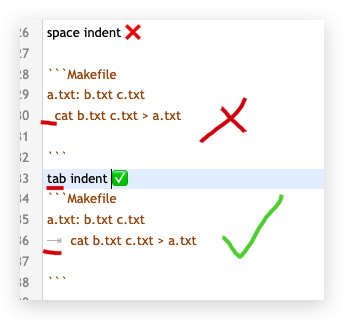
You need a real tab instead of space in front of g++ and rm commands.
https://stackoverflow.com/questions/23927212/makefile2-missing-separator-stop
https://stackoverflow.com/questions/920413/make-error-missing-separator
vscodespace to tab 🚀

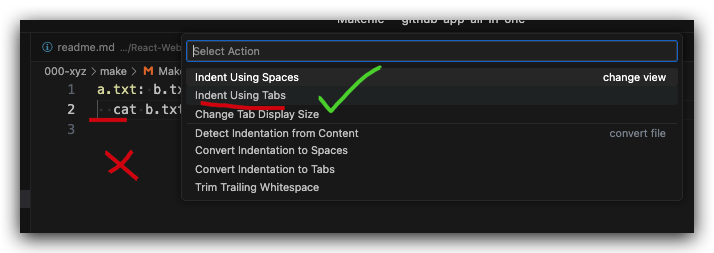
demos
$ touch b.txt c.txt
$ echo b file > b.txt
$ echo c file > c.txt
spaceindent ❌
a.txt: b.txt c.txt
cat b.txt c.txt > a.txt
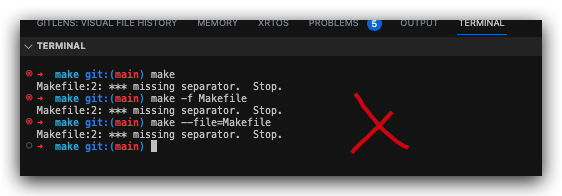
tabindent ✅
a.txt: b.txt c.txt
cat b.txt c.txt > a.txt
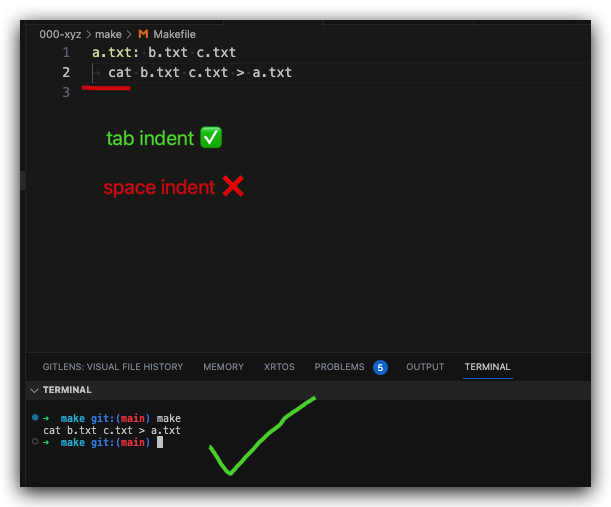
# default `Makefile`
$ make
cat b.txt c.txt > a.txt
# OR
$ make -f Makefile
cat b.txt c.txt > a.txt
# OR
$ make --file Makefile
cat b.txt c.txt > a.txt
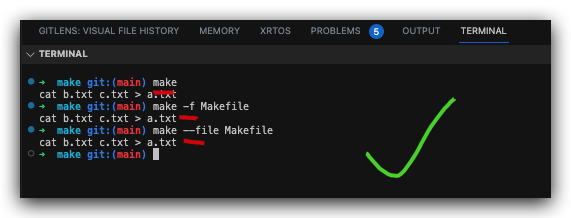
# OR
$ make -f your-custom-makefile-name-without-extension
# OR
$ make -f your-custom-makefile-name.with-any-extension
(🐞 反爬虫测试!打击盗版⚠️)如果你看到这个信息, 说明这是一篇剽窃的文章,请访问 https://www.cnblogs.com/xgqfrms/ 查看原创文章!
refs
Make
https://www.cnblogs.com/xgqfrms/p/17369547.html
CMake
https://www.cnblogs.com/xgqfrms/p/17059729.html
https://www.ruanyifeng.com/blog/2015/02/make.html
https://www.zhaixue.cc/makefile/makefile-intro.html
©xgqfrms 2012-2021
www.cnblogs.com/xgqfrms 发布文章使用:只允许注册用户才可以访问!
原创文章,版权所有©️xgqfrms, 禁止转载 🈲️,侵权必究⚠️!
本文首发于博客园,作者:xgqfrms,原文链接:https://www.cnblogs.com/xgqfrms/p/17426036.html
未经授权禁止转载,违者必究!


